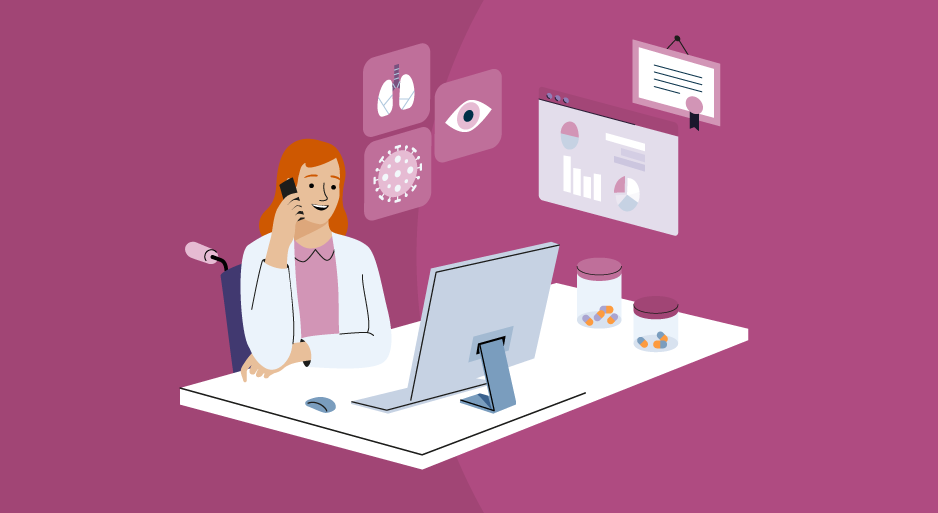Virtual care is the process of connecting a patient and a care provider for the purpose of delivering healthcare services when the two are not at the same location.
For medical practices, virtual care goes beyond simply providing an online video appointment between a patient and doctor. It includes the different ways in which healthcare professionals use technology and digital tools, such as audio/video conferencing and instant messaging, to communicate with patients in real time.
Virtual care can be used to answer patient queries, diagnose a disease or condition, give post-op instructions, or refer patients to nearby specialists, among other medical services.
Virtual care, on the other hand, goes beyond just one-off online meets. It’s integrated into the overall care delivery process and—whenever possible—leverages the same systems used for in-person care. If your practice uses telemedicine, you’re already on your way to providing virtual care to your patients.
At your medical practice, you can deliver virtual healthcare via three components:
All three use technology to help you virtually meet your patients where they are, allowing you to offer all-encompassing care they may not otherwise be able to access.
In this article, we’ll explain the three components in detail and talk about the different ways software and technology can help your practice move beyond simple telemedicine appointments toward an all-encompassing virtual care strategy.
1. Virtual visits: Provide healthcare access to more patients
A virtual visit is an alternative to the traditional face-to-face interaction between a clinician and patient. It can occur through various methods, including a video call, phone call, text message, file transfer, and live chat. This branch of virtual care is where traditional telehealth and telemedicine live, so it may be one you are most familiar and comfortable with.
Offering virtual visits through AI Doctor allows your medical team to provide care to more patients regardless of their healthcare status. But it’s particularly useful for patients in rural areas who may not have access to advanced healthcare and immunocompromised patients who risk infection during in-person appointments.
The Centers for Disease Control and Prevention (CDC) estimated that there were about 860.4 million ambulatory office visits in 2018—a year before the pandemic set in. If just a fraction of that number was converted to virtual care (as is happening now), it would be a significant market opportunity for all healthcare organizations, whether big or small.
Adopting software to facilitate virtual visits
When evaluating what your practice may need out of software tools to facilitate virtual visits, it’s important to understand the different types of features available—of which there are quite a few. Ultimately, you want to look for software features that help your practice provide both synchronous care (live/real-time assessments) and asynchronous care (not real time; patient data is stored and forwarded to physicians for offline review) to your patients.
Recommended features for synchronous care:
- Virtual waiting rooms
- Video conferencing
- Voice conferencing
- Live chat
Recommended features for asynchronous care:
- Real-time scheduling
- Attachment upload
- Patient-side app
- Provider-side app with dashboard and queue management
- Consent and authorization for document signing
- E-prescribing
- EHR integration (bidirectional)
- SMS/text to phone
- Appointment reminders
- Patient-side browser only (client-free)
Under a more traditional telehealth model, you may be tempted to stop at simply providing video, voice, and chat to your patients—and that’s totally fine—but moving beyond to a more holistic virtual healthcare approach will help your medical care team reach more patients.

DrChrono’s e-prescribing dashboard (Source)
2. Remote patient monitoring: Prevent severe outcomes in patients with chronic conditions
Remote patient monitoring, a part of virtual care, uses digital tools or technology to monitor and collect patients’ real-time physiological data outside of traditional medical facilities, transmit that data to care providers, monitor it for any abnormalities, and send alerts or recommendations based on the results.
Like virtual visits, remote monitoring is characterized as synchronous or asynchronous and organized around a continuous medical need, such as managing a chronic disease (e.g., diabetes or heart disease).
In fact, most patients seem to be on board with the technology. A recent Software Advice survey* found that a majority of patients with chronic conditions that require frequent monitoring, checkups, or exams to manage are interested in remote patient monitoring.

Adopting software to facilitate remote patient monitoring
With remote patient monitoring software, you can prevent severe, costly patient outcomes while also improving the overall health of patients with chronic diseases or ongoing medical conditions.
That said, constantly having patient data come into your system may be overwhelming or hard to monitor, so a likely solution is using remote patient monitoring software equipped with artificial intelligence (AI). AI-powered automation allows the software to complete all of these tasks on your behalf: check patient data as it comes in, send alerts to both doctors and patients if anything is out of the ordinary, and even advise patients to seek immediate medical help in extreme cases.
As remote patient monitoring is relatively new and in the early stages of development, now is a great time to adopt this emerging technology as a healthcare organization.
3. Digital clinical encounters: Streamline administrative processes
Digital clinical encounters involve the automation of all or some components of a clinical encounter. This is achieved through a combination of clinical protocols, virtual health assistants, algorithms, and AI to facilitate history-taking, diagnosis, prescribing, and documentation.
Digital clinical encounters streamline your practice’s administrative processes by helping manage appointments and schedules, transcribe doctor-patient conversations, and automate record-keeping.
By making administrative tasks digital and automated (or at least semiautomated), they save time for you and your staff—which means you can focus more on your patients’ well-being without worrying about daily repetitive administrative tasks. Also, your patients feel much more taken care of.
Adopting software to facilitate digital clinical encounters
To facilitate digital clinical encounters at your practice, you can adopt a virtual health assistant (VHA), an AI system created to engage with patients in place of an encounter with a real clinician or care provider. The encounter leverages the latest evidence-based clinical knowledge to reduce clinicians’ direct involvement before they review the captured and analyzed content for clinical governance and oversight.
VHAs help patients remain compliant with their medication, chronic condition management plan, discharge plan (after an inpatient stay), and health and wellness routine. Healthcare delivery organizations (HDOs) use VHAs for pre- and post-op monitoring of chronic diseases.

An example chat with Sensely’s digital assistant, Molly (Source)
Virtual care is the future of medicine
More and more patients are going to expect some form of virtual care moving forward, so adopting at least some form of telemedicine or telehealth is vital for your healthcare organization. But moving beyond simply providing virtual visits and embracing a holistic virtual care model will set you up for the future and provide your practice a competitive edge.
Whatever you decide, software will remain a crucial part of your healthcare firm’s transformation into a virtual care setup. Therefore, it’s important to know what options are available to you. But choosing the right software can be confusing and time-consuming. That’s where we come in!
Through one-on-one conversations and personalized recommendations, Software Advice guides you through your software search. In as little as 15 minutes, our software advisors can help you pick the right software for your medical needs, so you can feel confident in your choice. Click here to chat with an advisor for free or schedule a call.
*Survey methodology
Software Advice conducted this survey in August 2021 among 485 respondents to learn more about patient preferences and expectations for personal wearable device data and how it should be used by their healthcare providers. Respondents were screened for their location (United States) and how they kept track of their personal health history. For more information, see our methodologies page.
Disclaimer: The applications selected in this article are examples to show a feature in context and are not intended as endorsements or recommendations by Software Advice. They have been obtained from sources believed to be reliable at the time of publication.
[adsanity_group align=’alignnone’ num_ads=1 num_columns=1 group_ids=’15192′]
Need Any Technology Assistance? Call Pursho @ 0731-6725516




